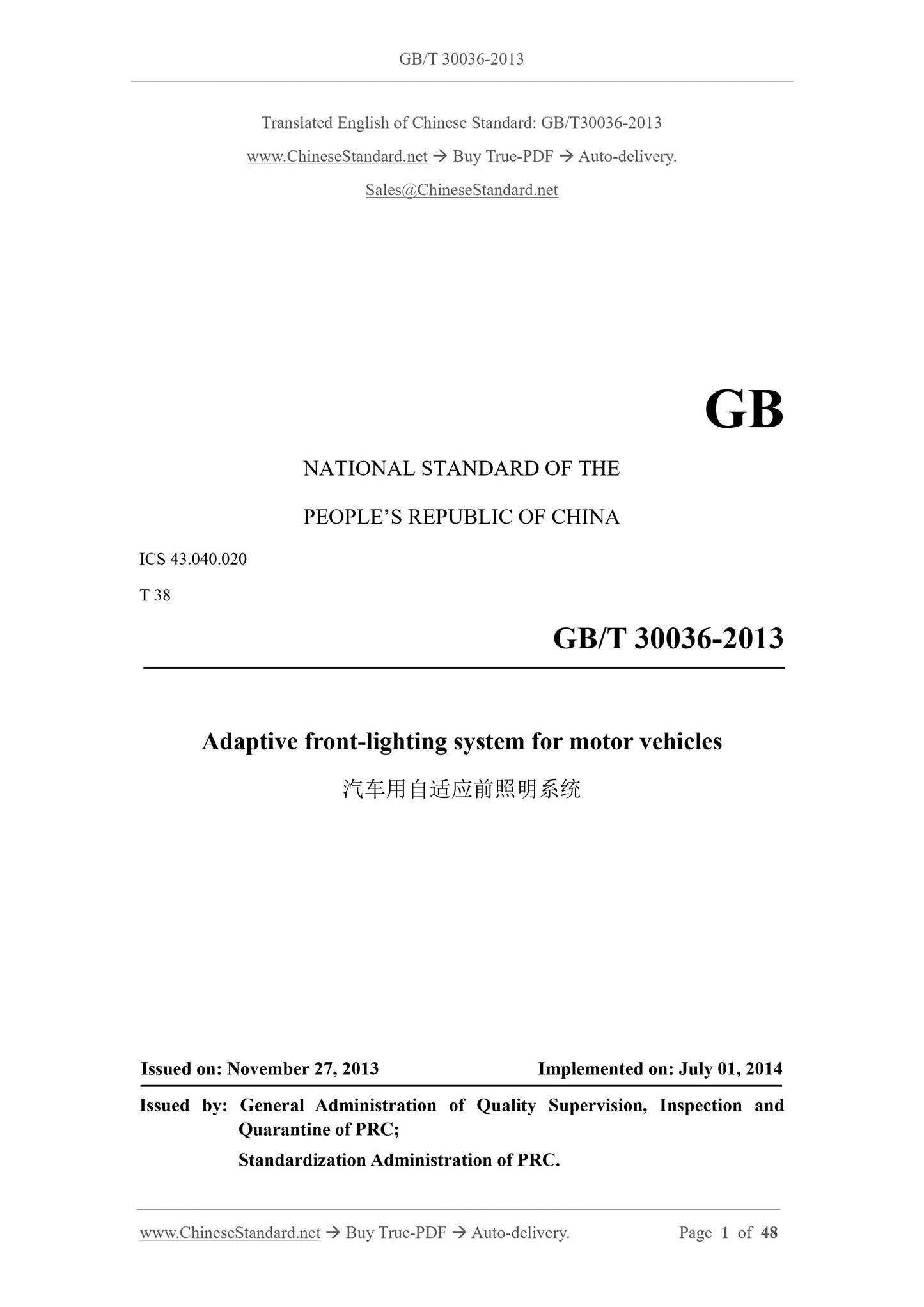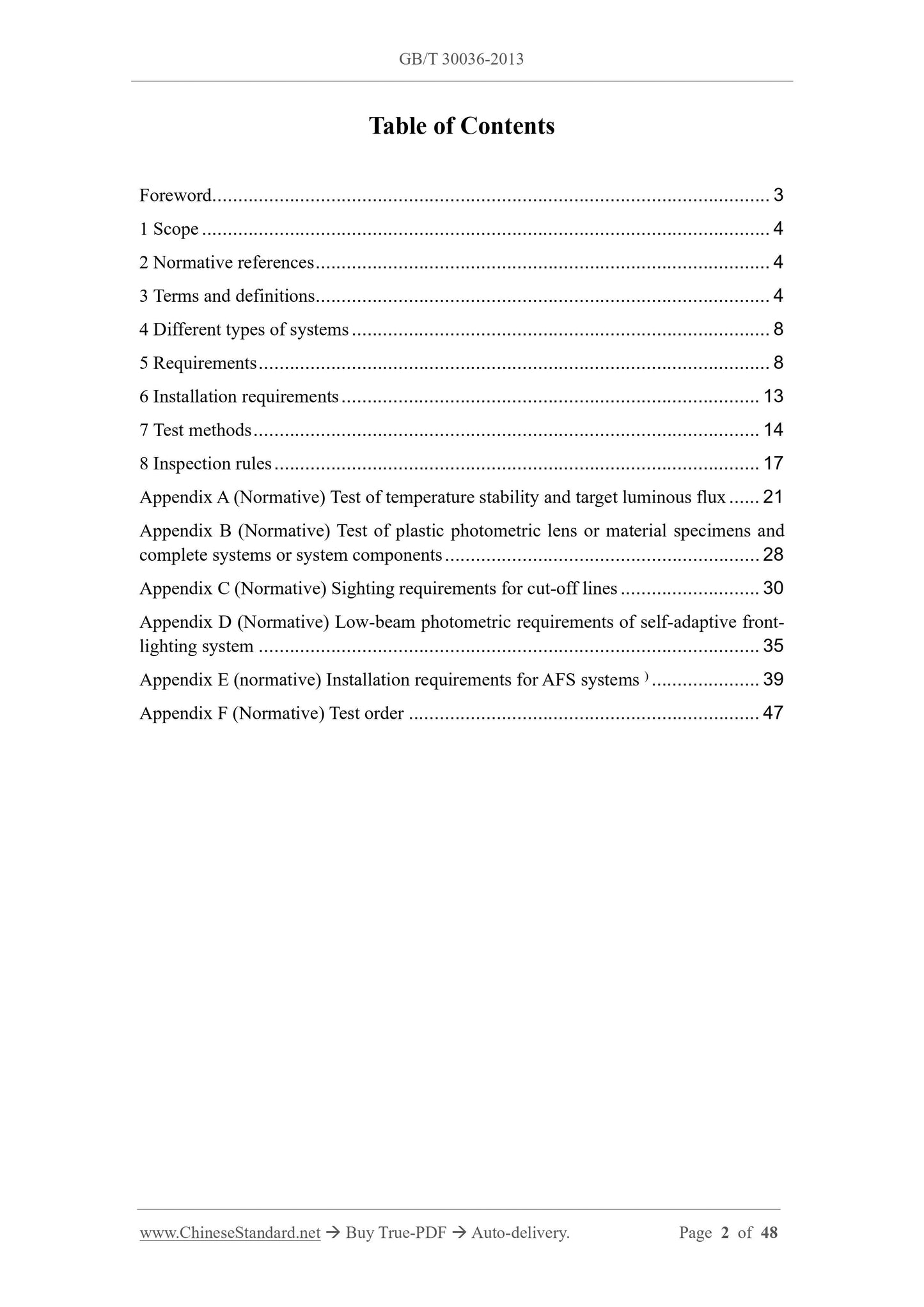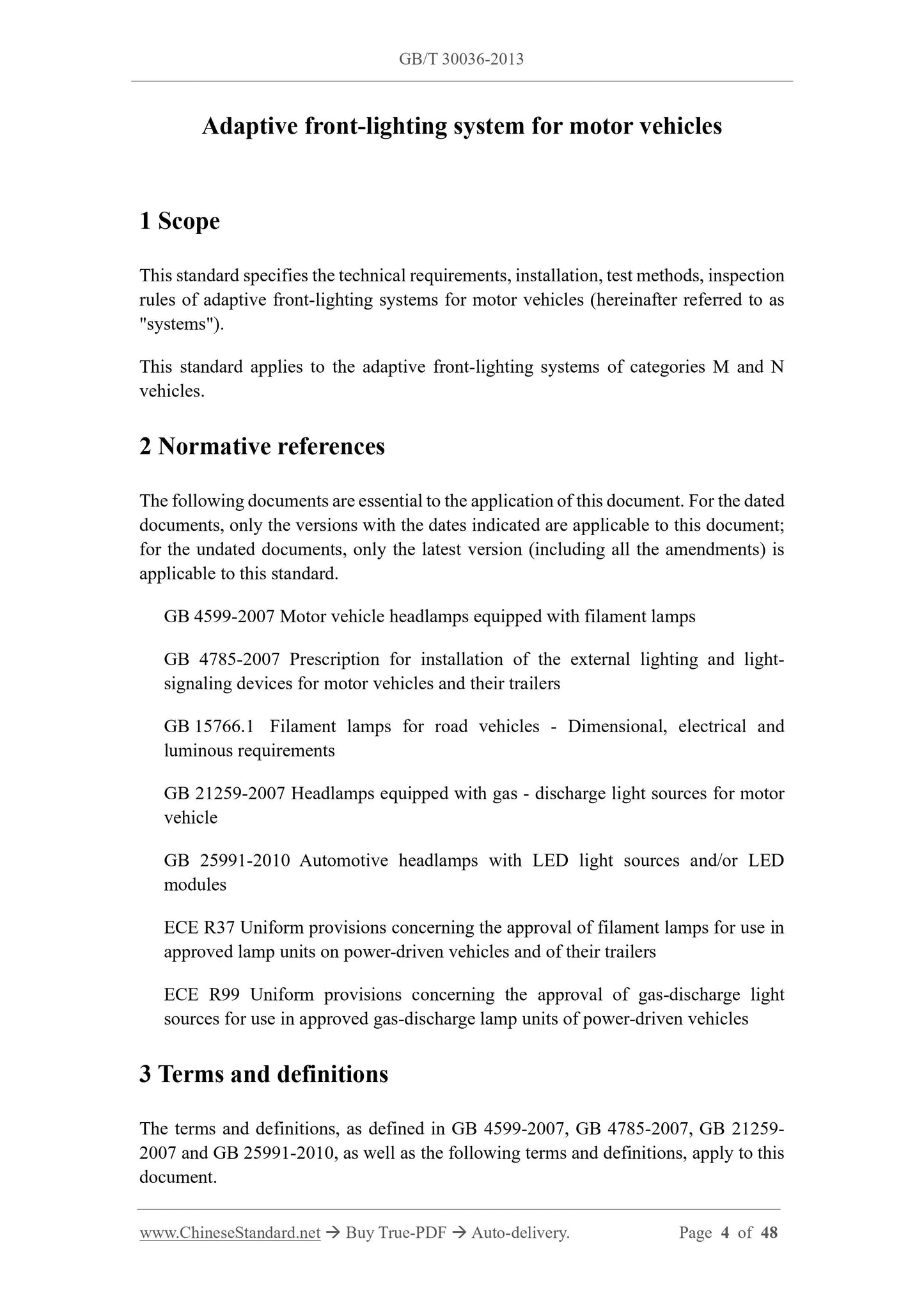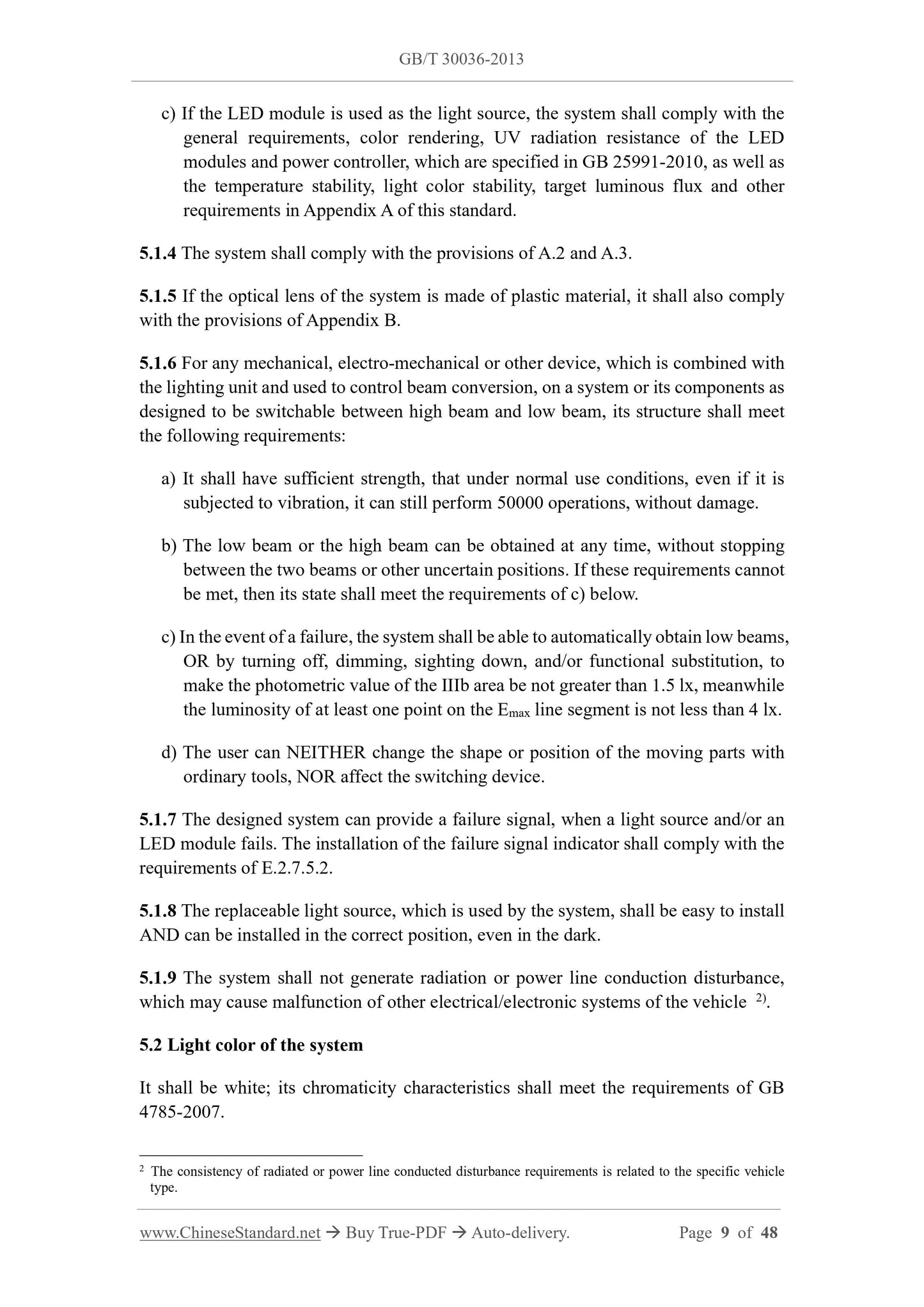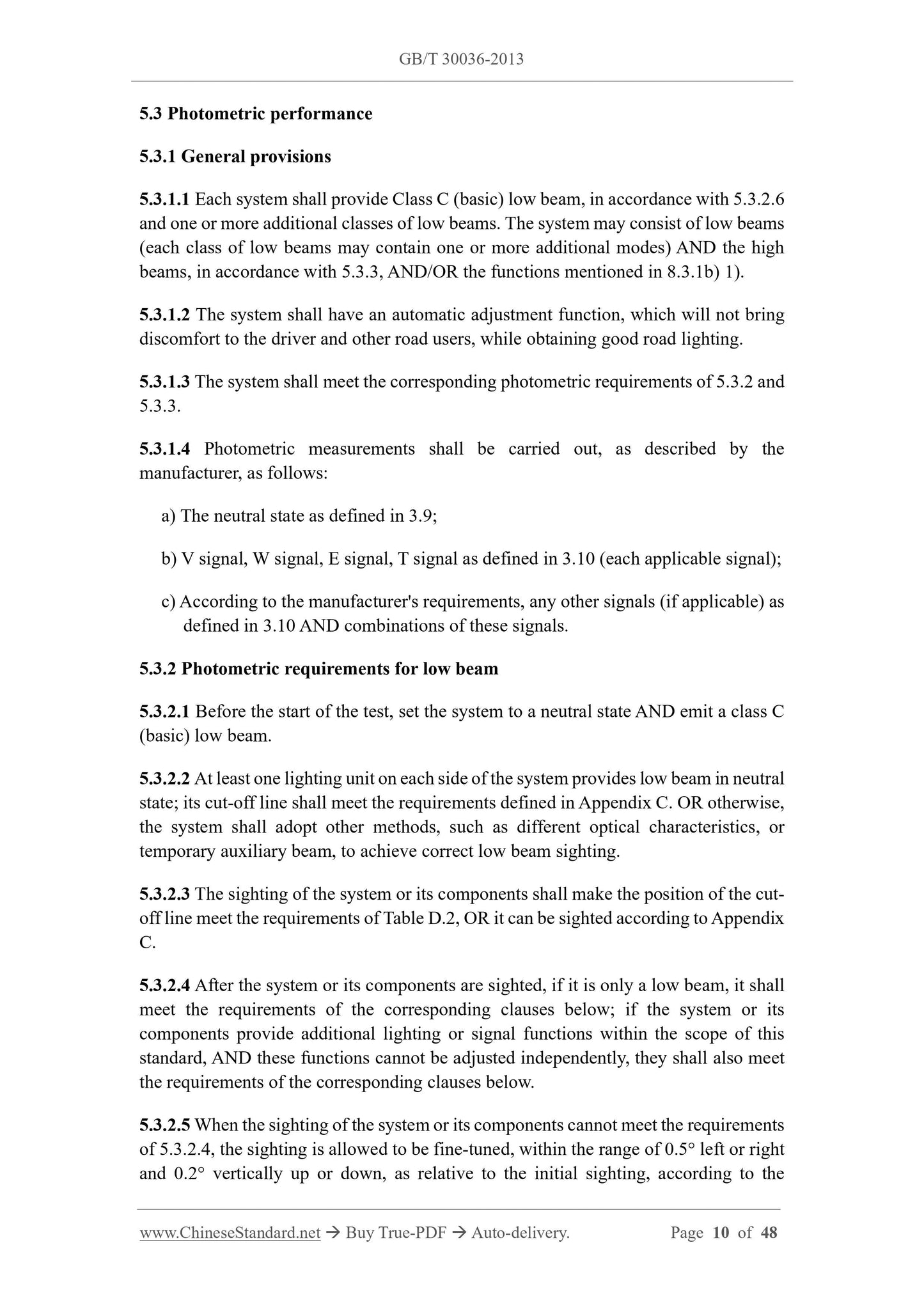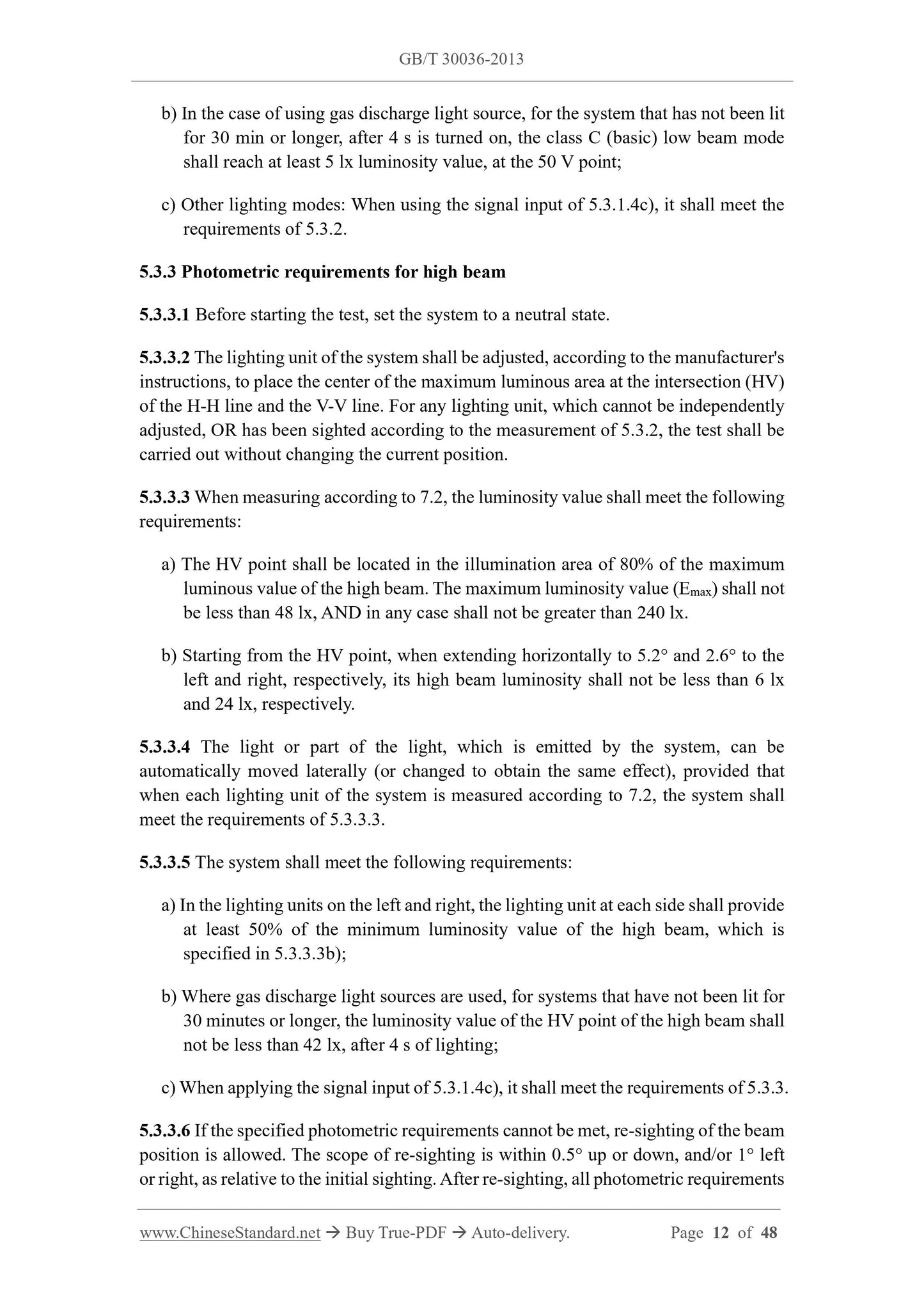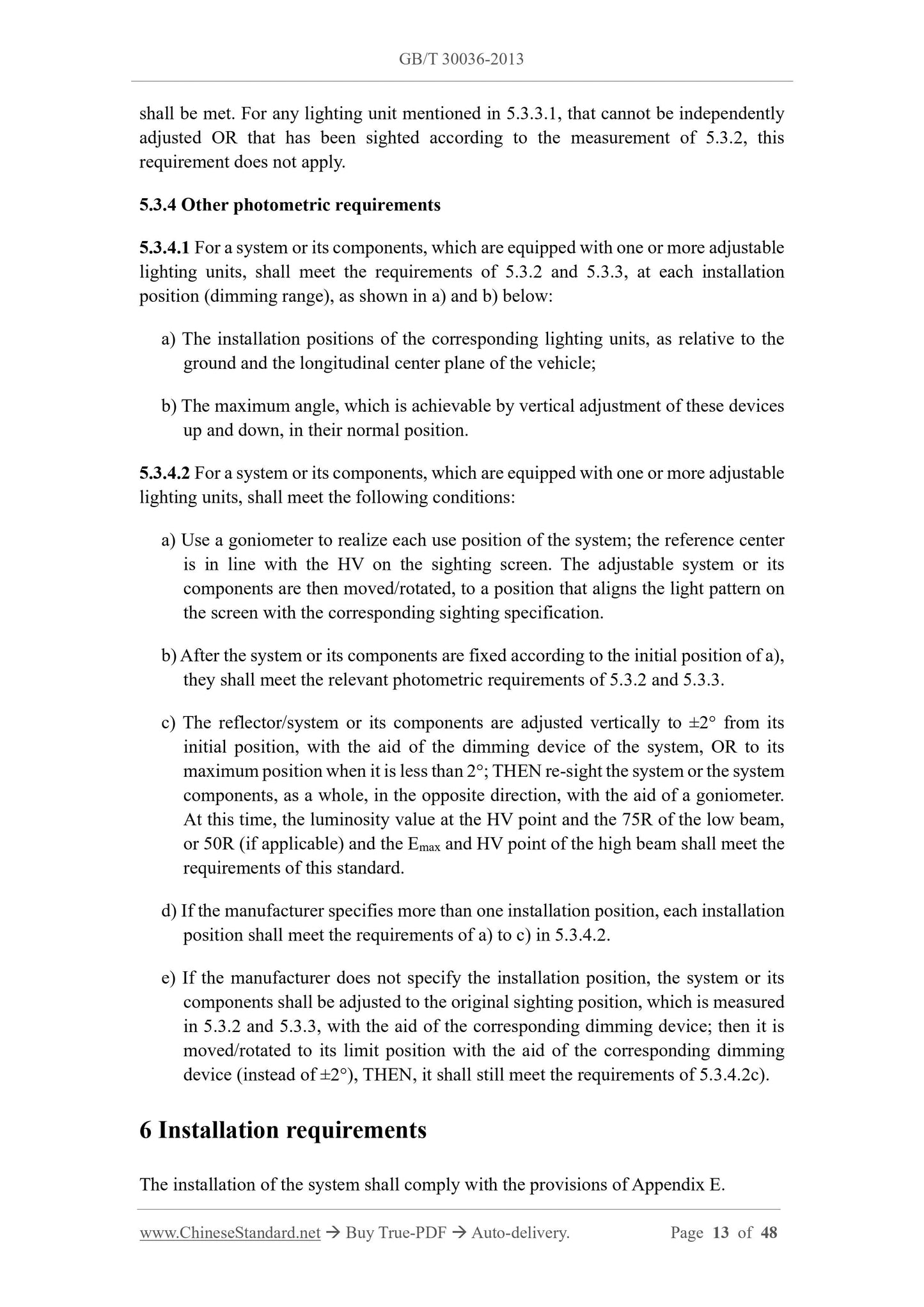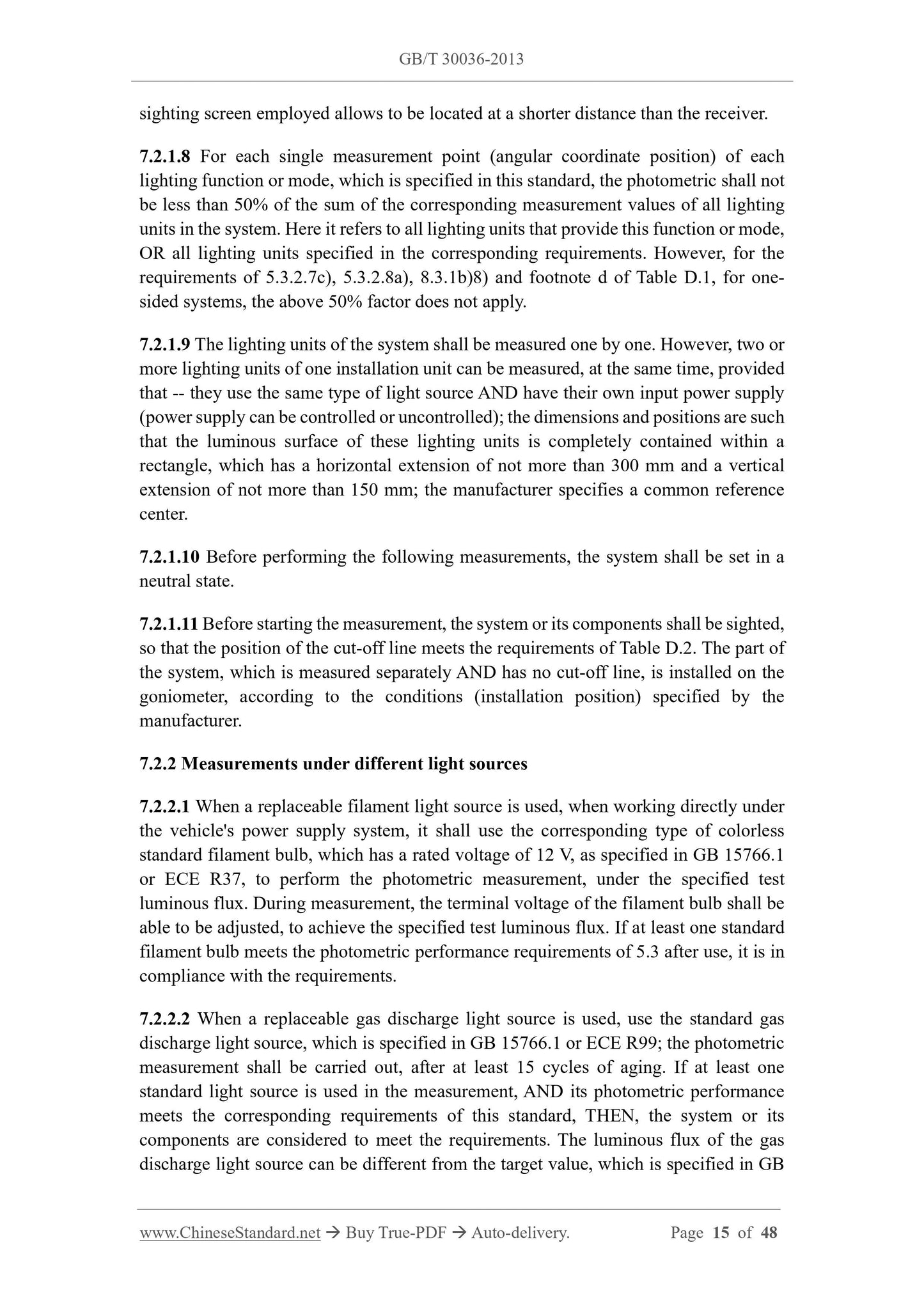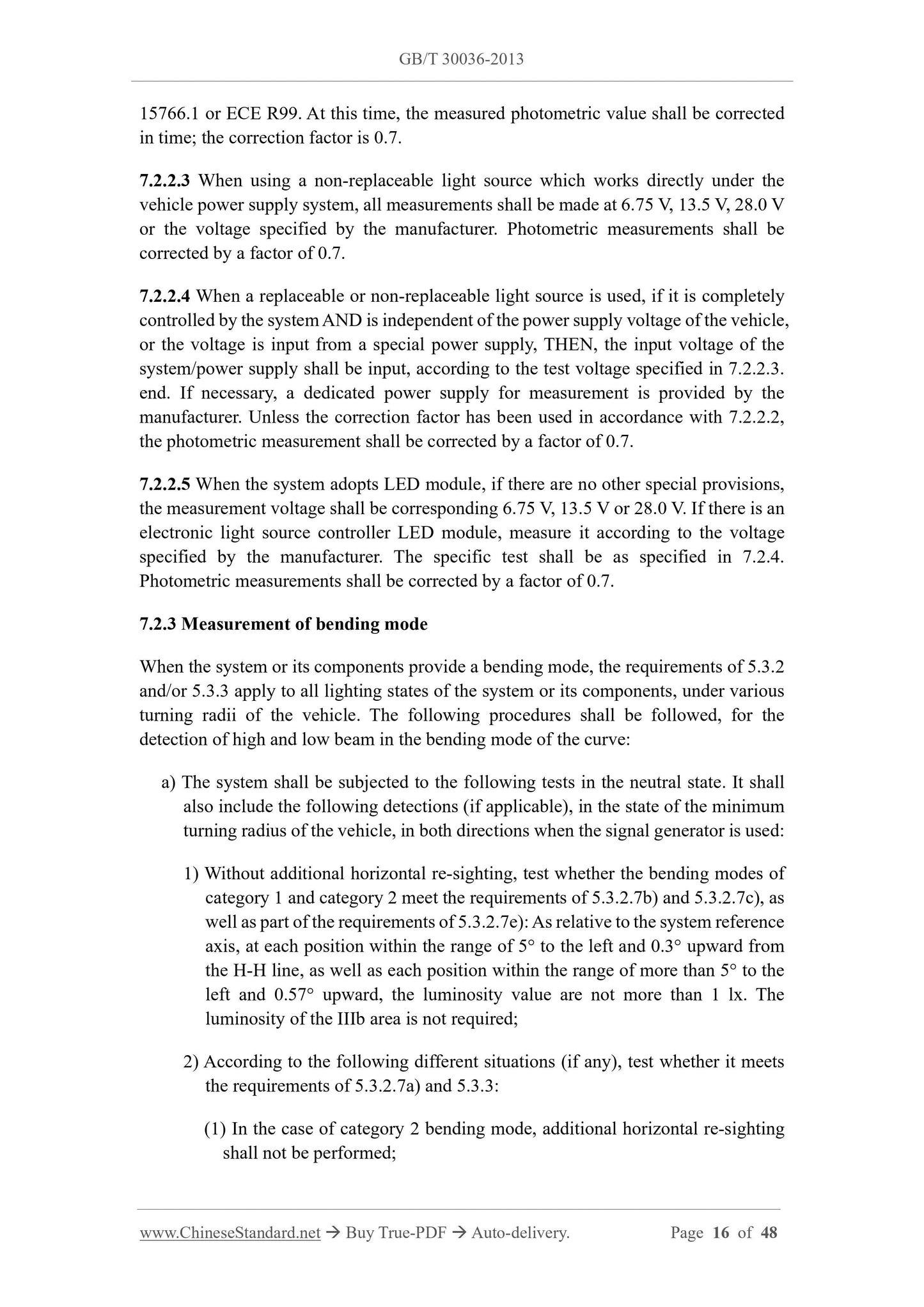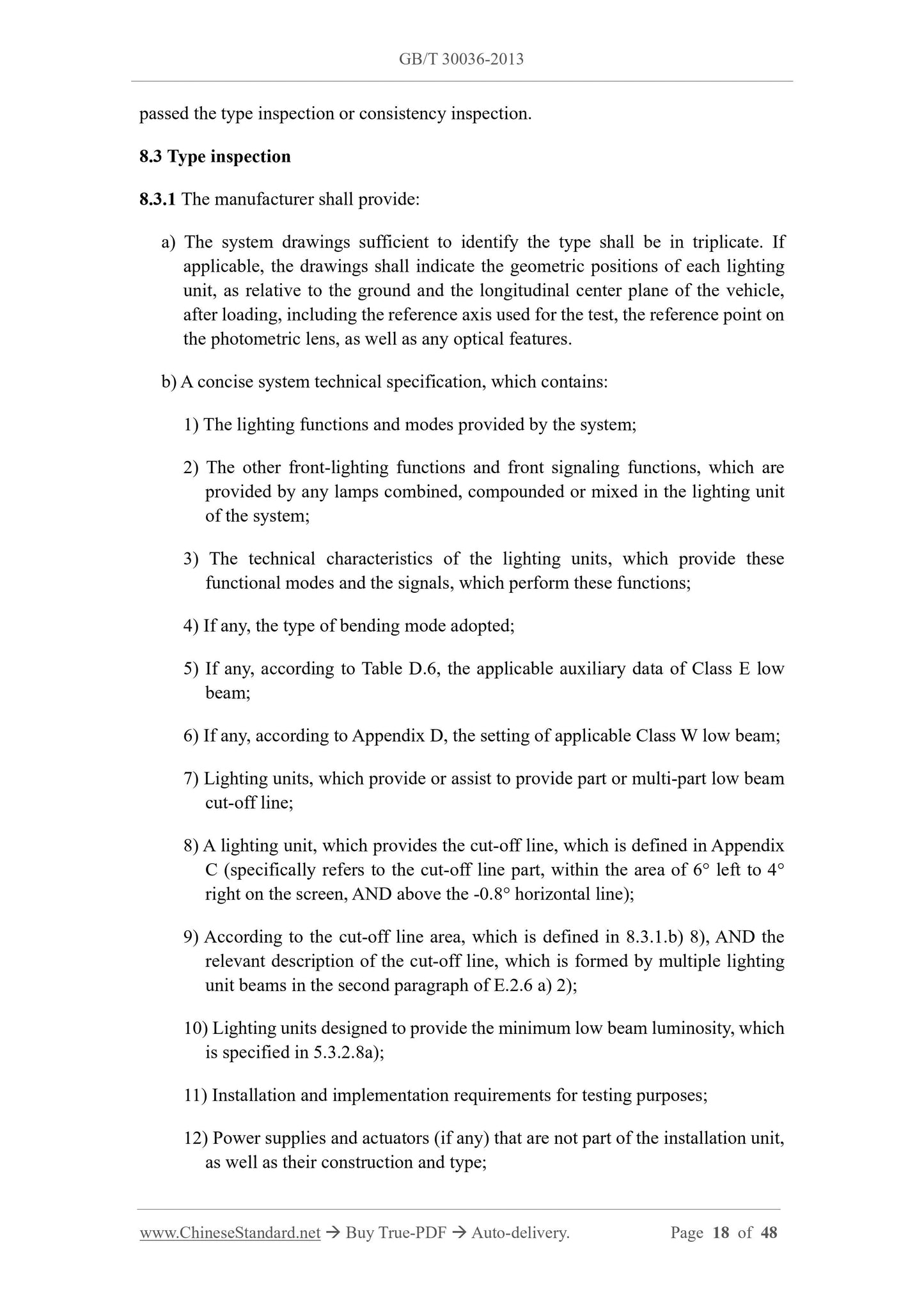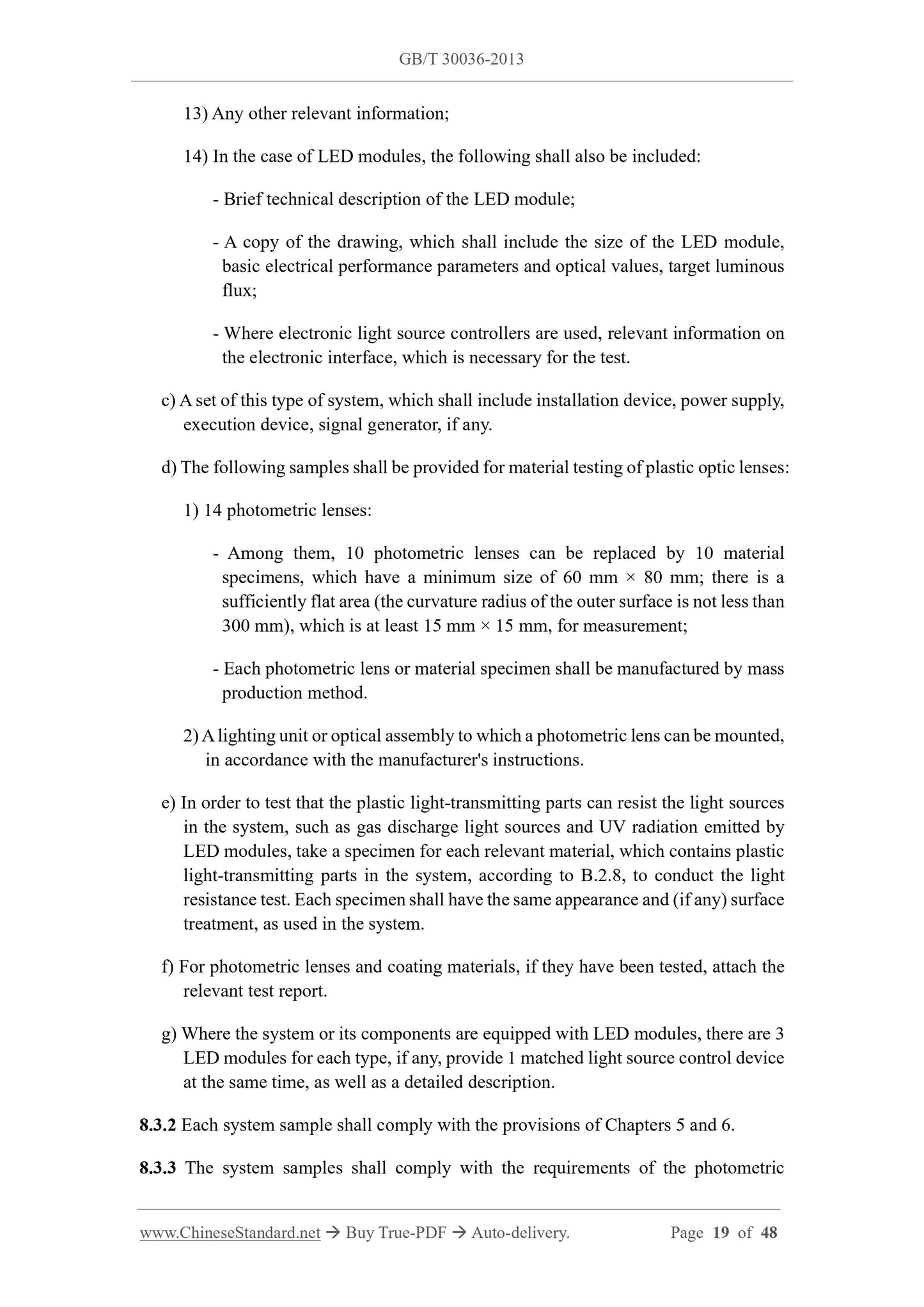PayPal, credit cards. Download editable-PDF & invoice In 1 second!
GB/T 30036-2013 English PDF (GBT30036-2013)
GB/T 30036-2013 English PDF (GBT30036-2013)
Precio habitual
$485.00 USD
Precio habitual
Precio de oferta
$485.00 USD
Precio unitario
/
por
Los gastos de envío se calculan en la pantalla de pago.
No se pudo cargar la disponibilidad de retiro
Delivery: 3 seconds. Download true-PDF + Invoice.
Get QUOTATION in 1-minute: Click GB/T 30036-2013
Historical versions: GB/T 30036-2013
Preview True-PDF (Reload/Scroll if blank)
GB/T 30036-2013: Adaptive front-lighting system for motor vehicles
GB/T 30036-2013
NATIONAL STANDARD OF THE
PEOPLE’S REPUBLIC OF CHINA
ICS 43.040.020
T 38
Adaptive front-lighting system for motor vehicles
ISSUED ON: NOVEMBER 27, 2013
IMPLEMENTED ON: JULY 01, 2014
Issued by: General Administration of Quality Supervision, Inspection and
Quarantine of PRC;
Standardization Administration of PRC.
Table of Contents
Foreword ... 3
1 Scope ... 4
2 Normative references ... 4
3 Terms and definitions... 4
4 Different types of systems ... 8
5 Requirements ... 8
6 Installation requirements ... 13
7 Test methods ... 14
8 Inspection rules ... 17
Appendix A (Normative) Test of temperature stability and target luminous flux ... 21
Appendix B (Normative) Test of plastic photometric lens or material specimens and
complete systems or system components ... 28
Appendix C (Normative) Sighting requirements for cut-off lines ... 30
Appendix D (Normative) Low-beam photometric requirements of self-adaptive front-
lighting system ... 35
Appendix E (normative) Installation requirements for AFS systems ) ... 39
Appendix F (Normative) Test order ... 47
Adaptive front-lighting system for motor vehicles
1 Scope
This standard specifies the technical requirements, installation, test methods, inspection
rules of adaptive front-lighting systems for motor vehicles (hereinafter referred to as
"systems").
This standard applies to the adaptive front-lighting systems of categories M and N
vehicles.
2 Normative references
The following documents are essential to the application of this document. For the dated
documents, only the versions with the dates indicated are applicable to this document;
for the undated documents, only the latest version (including all the amendments) is
applicable to this standard.
GB 4599-2007 Motor vehicle headlamps equipped with filament lamps
GB 4785-2007 Prescription for installation of the external lighting and light-
signaling devices for motor vehicles and their trailers
GB 15766.1 Filament lamps for road vehicles - Dimensional, electrical and
luminous requirements
GB 21259-2007 Headlamps equipped with gas - discharge light sources for motor
vehicle
GB 25991-2010 Automotive headlamps with LED light sources and/or LED
modules
ECE R37 Uniform provisions concerning the approval of filament lamps for use in
approved lamp units on power-driven vehicles and of their trailers
ECE R99 Uniform provisions concerning the approval of gas-discharge light
sources for use in approved gas-discharge lamp units of power-driven vehicles
3 Terms and definitions
The terms and definitions, as defined in GB 4599-2007, GB 4785-2007, GB 21259-
2007 and GB 25991-2010, as well as the following terms and definitions, apply to this
document.
c) If the LED module is used as the light source, the system shall comply with the
general requirements, color rendering, UV radiation resistance of the LED
modules and power controller, which are specified in GB 25991-2010, as well as
the temperature stability, light color stability, target luminous flux and other
requirements in Appendix A of this standard.
5.1.4 The system shall comply with the provisions of A.2 and A.3.
5.1.5 If the optical lens of the system is made of plastic material, it shall also comply
with the provisions of Appendix B.
5.1.6 For any mechanical, electro-mechanical or other device, which is combined with
the lighting unit and used to control beam conversion, on a system or its components as
designed to be switchable between high beam and low beam, its structure shall meet
the following requirements:
a) It shall have sufficient strength, that under normal use conditions, even if it is
subjected to vibration, it can still perform 50000 operations, without damage.
b) The low beam or the high beam can be obtained at any time, without stopping
between the two beams or other uncertain positions. If these requirements cannot
be met, then its state shall meet the requirements of c) below.
c) In the event of a failure, the system shall be able to automatically obtain low beams,
OR by turning off, dimming, sighting down, and/or functional substitution, to
make the photometric value of the IIIb area be not greater than 1.5 lx, meanwhile
the luminosity of at least one point on the Emax line segment is not less than 4 lx.
d) The user can NEITHER change the shape or position of the moving parts with
ordinary tools, NOR affect the switching device.
5.1.7 The designed system can provide a failure signal, when a light source and/or an
LED module fails. The installation of the failure signal indicator shall comply with the
requirements of E.2.7.5.2.
5.1.8 The replaceable light source, which is used by the system, shall be easy to install
AND can be installed in the correct position, even in the dark.
5.1.9 The system shall not generate radiation or power line conduction disturbance,
which may cause malfunction of other electrical/electronic systems of the vehicle 2).
5.2 Light color of the system
It shall be white; its chromaticity characteristics shall meet the requirements of GB
4785-2007.
2 The consistency of radiated or power line conducted disturbance requirements is related to the specific vehicle
type.
5.3 Photometric performance
5.3.1 General provisions
5.3.1.1 Each system shall provide Class C (basic) low beam, in accordance with 5.3.2.6
and one or more additional classes of low beams. The system may consist of low beams
(each class of low beams may contain one or more additional modes) AND the high
beams, in accordance with 5.3.3, AND/OR the functions mentioned in 8.3.1b) 1).
5.3.1.2 The system shall have an automatic adjustment function, which will not bring
discomfort to the driver and other road users, while obtaining good road lighting.
5.3.1.3 The system shall meet the corresponding photometric requirements of 5.3.2 and
5.3.3.
5.3.1.4 Photometric measurements shall be carried out, as described by the
manufacturer, as follows:
a) The neutral state as defined in 3.9;
b) V signal, W signal, E signal, T signal as defined in 3.10 (each applicable signal);
c) According to the manufacturer's requirements, any other signals (if applicable) as
defined in 3.10 AND combinations of these signals.
5.3.2 Photometric requirements for low beam
5.3.2.1 Before the start of the test, set the system to a neutral state AND emit a class C
(basic) low beam.
5.3.2.2 At least one lighting unit on each side of the system provides low beam in neutral
state; its cut-off line shall meet the requirements defined in Appendix C. OR otherwise,
the system shall adopt other methods, such as different optical characteristics, or
temporary auxiliary beam, to achieve correct low beam sighting.
5.3.2.3 The sighting of the system or its components shall make the position of the cut-
off line meet the requirements of Table D.2, OR it can be sighted according to Appendix
C.
5.3.2.4 After the system or its components are sighted, if it is only a low beam, it shall
meet the requirements of the corresponding clauses below; if the system or its
components provide additional lighting or signal functions within the scope of this
standard, AND these functions cannot be adjusted independently, they shall also meet
the requirements of the corresponding clauses below.
5.3.2.5 When the sighting of the system or its components cannot meet the requirements
of 5.3.2.4, the sighting is allowed to be fine-tuned, within th...
Get QUOTATION in 1-minute: Click GB/T 30036-2013
Historical versions: GB/T 30036-2013
Preview True-PDF (Reload/Scroll if blank)
GB/T 30036-2013: Adaptive front-lighting system for motor vehicles
GB/T 30036-2013
NATIONAL STANDARD OF THE
PEOPLE’S REPUBLIC OF CHINA
ICS 43.040.020
T 38
Adaptive front-lighting system for motor vehicles
ISSUED ON: NOVEMBER 27, 2013
IMPLEMENTED ON: JULY 01, 2014
Issued by: General Administration of Quality Supervision, Inspection and
Quarantine of PRC;
Standardization Administration of PRC.
Table of Contents
Foreword ... 3
1 Scope ... 4
2 Normative references ... 4
3 Terms and definitions... 4
4 Different types of systems ... 8
5 Requirements ... 8
6 Installation requirements ... 13
7 Test methods ... 14
8 Inspection rules ... 17
Appendix A (Normative) Test of temperature stability and target luminous flux ... 21
Appendix B (Normative) Test of plastic photometric lens or material specimens and
complete systems or system components ... 28
Appendix C (Normative) Sighting requirements for cut-off lines ... 30
Appendix D (Normative) Low-beam photometric requirements of self-adaptive front-
lighting system ... 35
Appendix E (normative) Installation requirements for AFS systems ) ... 39
Appendix F (Normative) Test order ... 47
Adaptive front-lighting system for motor vehicles
1 Scope
This standard specifies the technical requirements, installation, test methods, inspection
rules of adaptive front-lighting systems for motor vehicles (hereinafter referred to as
"systems").
This standard applies to the adaptive front-lighting systems of categories M and N
vehicles.
2 Normative references
The following documents are essential to the application of this document. For the dated
documents, only the versions with the dates indicated are applicable to this document;
for the undated documents, only the latest version (including all the amendments) is
applicable to this standard.
GB 4599-2007 Motor vehicle headlamps equipped with filament lamps
GB 4785-2007 Prescription for installation of the external lighting and light-
signaling devices for motor vehicles and their trailers
GB 15766.1 Filament lamps for road vehicles - Dimensional, electrical and
luminous requirements
GB 21259-2007 Headlamps equipped with gas - discharge light sources for motor
vehicle
GB 25991-2010 Automotive headlamps with LED light sources and/or LED
modules
ECE R37 Uniform provisions concerning the approval of filament lamps for use in
approved lamp units on power-driven vehicles and of their trailers
ECE R99 Uniform provisions concerning the approval of gas-discharge light
sources for use in approved gas-discharge lamp units of power-driven vehicles
3 Terms and definitions
The terms and definitions, as defined in GB 4599-2007, GB 4785-2007, GB 21259-
2007 and GB 25991-2010, as well as the following terms and definitions, apply to this
document.
c) If the LED module is used as the light source, the system shall comply with the
general requirements, color rendering, UV radiation resistance of the LED
modules and power controller, which are specified in GB 25991-2010, as well as
the temperature stability, light color stability, target luminous flux and other
requirements in Appendix A of this standard.
5.1.4 The system shall comply with the provisions of A.2 and A.3.
5.1.5 If the optical lens of the system is made of plastic material, it shall also comply
with the provisions of Appendix B.
5.1.6 For any mechanical, electro-mechanical or other device, which is combined with
the lighting unit and used to control beam conversion, on a system or its components as
designed to be switchable between high beam and low beam, its structure shall meet
the following requirements:
a) It shall have sufficient strength, that under normal use conditions, even if it is
subjected to vibration, it can still perform 50000 operations, without damage.
b) The low beam or the high beam can be obtained at any time, without stopping
between the two beams or other uncertain positions. If these requirements cannot
be met, then its state shall meet the requirements of c) below.
c) In the event of a failure, the system shall be able to automatically obtain low beams,
OR by turning off, dimming, sighting down, and/or functional substitution, to
make the photometric value of the IIIb area be not greater than 1.5 lx, meanwhile
the luminosity of at least one point on the Emax line segment is not less than 4 lx.
d) The user can NEITHER change the shape or position of the moving parts with
ordinary tools, NOR affect the switching device.
5.1.7 The designed system can provide a failure signal, when a light source and/or an
LED module fails. The installation of the failure signal indicator shall comply with the
requirements of E.2.7.5.2.
5.1.8 The replaceable light source, which is used by the system, shall be easy to install
AND can be installed in the correct position, even in the dark.
5.1.9 The system shall not generate radiation or power line conduction disturbance,
which may cause malfunction of other electrical/electronic systems of the vehicle 2).
5.2 Light color of the system
It shall be white; its chromaticity characteristics shall meet the requirements of GB
4785-2007.
2 The consistency of radiated or power line conducted disturbance requirements is related to the specific vehicle
type.
5.3 Photometric performance
5.3.1 General provisions
5.3.1.1 Each system shall provide Class C (basic) low beam, in accordance with 5.3.2.6
and one or more additional classes of low beams. The system may consist of low beams
(each class of low beams may contain one or more additional modes) AND the high
beams, in accordance with 5.3.3, AND/OR the functions mentioned in 8.3.1b) 1).
5.3.1.2 The system shall have an automatic adjustment function, which will not bring
discomfort to the driver and other road users, while obtaining good road lighting.
5.3.1.3 The system shall meet the corresponding photometric requirements of 5.3.2 and
5.3.3.
5.3.1.4 Photometric measurements shall be carried out, as described by the
manufacturer, as follows:
a) The neutral state as defined in 3.9;
b) V signal, W signal, E signal, T signal as defined in 3.10 (each applicable signal);
c) According to the manufacturer's requirements, any other signals (if applicable) as
defined in 3.10 AND combinations of these signals.
5.3.2 Photometric requirements for low beam
5.3.2.1 Before the start of the test, set the system to a neutral state AND emit a class C
(basic) low beam.
5.3.2.2 At least one lighting unit on each side of the system provides low beam in neutral
state; its cut-off line shall meet the requirements defined in Appendix C. OR otherwise,
the system shall adopt other methods, such as different optical characteristics, or
temporary auxiliary beam, to achieve correct low beam sighting.
5.3.2.3 The sighting of the system or its components shall make the position of the cut-
off line meet the requirements of Table D.2, OR it can be sighted according to Appendix
C.
5.3.2.4 After the system or its components are sighted, if it is only a low beam, it shall
meet the requirements of the corresponding clauses below; if the system or its
components provide additional lighting or signal functions within the scope of this
standard, AND these functions cannot be adjusted independently, they shall also meet
the requirements of the corresponding clauses below.
5.3.2.5 When the sighting of the system or its components cannot meet the requirements
of 5.3.2.4, the sighting is allowed to be fine-tuned, within th...
Share
